 Back at the end of 2010, we realized there was a substantial need in the marketplace for remote control of roller blind motors that regular folks could purchase to make their own roller shades.
Back at the end of 2010, we realized there was a substantial need in the marketplace for remote control of roller blind motors that regular folks could purchase to make their own roller shades.
As a result, we started manufacturing tubular motors, created our RollerTrol™ website (Roller + Control), and sales of these blind motors grew very quickly. They slide easily into a tube and you can retrofit your existing shades with our simple multi-channel remote controls.
We later expanded our manufacturing line to include motorized window and skylight openers.
One of the Best Home Automation Systems?
The age of home automation and IoT is upon us, and since we have been working with home control systems for over 40 years, we decided to support the non-proprietary Raspberry Pi system, based on 5 principal components:
1. The Raspberry Pi Single Board Computer
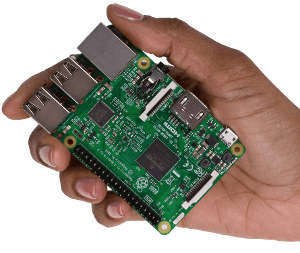 The amazing Raspberry Pi single board computer (SBC) made its educational debut in 2012 - this very capable, very affordable computer, running the Linux operating system (Raspbian version), was designed at Cambridge University primarily as a low cost solution for students to learn programming.
The amazing Raspberry Pi single board computer (SBC) made its educational debut in 2012 - this very capable, very affordable computer, running the Linux operating system (Raspbian version), was designed at Cambridge University primarily as a low cost solution for students to learn programming.
It was predicted to sell perhaps 10,000 units, but demand soared, and it actually sold several million in a few short years. It has enough power to run our home automation system AND do regular computer activities like sending email, browsing the net, running a spreadsheet, etc. (all standard programs that come with it).
There is a huge user community, with vast resources about how to do things with the Raspberry Pi. If you have a particular application for it, chances are that someone has already done it and written about it in the user forums.
2. The Node-RED Visual Design Automation Software
This is the origin of the Node part.
In 2015, the equally amazing Node-RED visual design system was added to the default program list of the Raspbian operating system for the Pi. This is a great piece of software for setting up your smart home.
Node-RED was developed by some clever folks at IBM, and later declared as "open source" prior to it being included in the Raspbian OS for the Pi. It runs as a web server, so any web enabled device can view it.
The visual design system of Node-RED uses a "drag 'n drop" system that facilitates very rapid application development (RAD) of automated systems, as seen in the following picture. You just drag nodes from the palette on the left onto the center workspace, and connect the nodes with a click/drag movement on the appropriate ends.
In this picture, we created a simple lighting scenario for our home theater system, using the Alexa™ voice control system, and we frankly don't see how it could be any easier ...
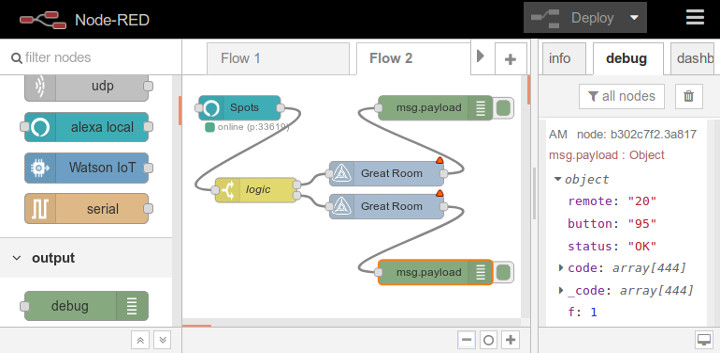
When you drag dashboard nodes onto the workspace, Node-RED automatically creates a fully functional dashboard. This is an example (not related to our spotlight flow above):
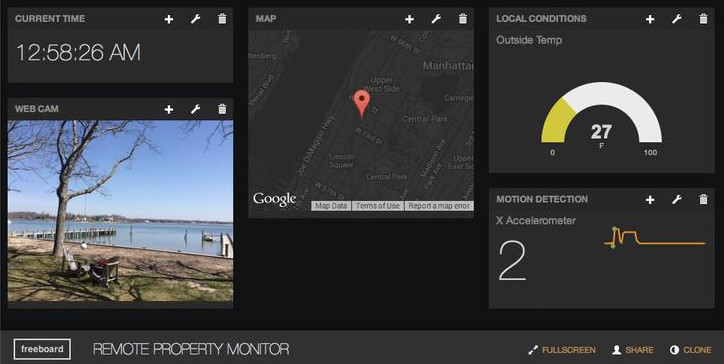
This terrific combination of user-friendly software and hardware provides us with an excellent platform for quickly building a smart home automation system (or a commercial system for, say, a greenhouse).
3. The ESP-32 Used as a Wireless Sensor Node
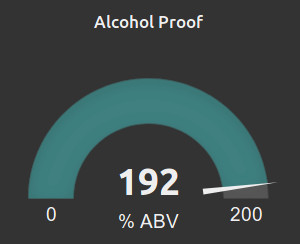 The advanced ESP32 microcontroller from Espressif®, with its built-in WiFi, makes a perfect wireless sensor node (aka 'mote') for the Internet of Things (IoT).
The advanced ESP32 microcontroller from Espressif®, with its built-in WiFi, makes a perfect wireless sensor node (aka 'mote') for the Internet of Things (IoT).
This example gauge, generated automatically in Node-RED on the Pi, is displaying data sent wirelessly from an ESP-32 via MQTT. It is used to determine the alcohol content of spirits produced in a distillery.
This inexpensive WiFi microcontroller can be very easily programmed with Micropython to take on the role as a wireless sensor, transferring data to the Raspberry Pi dashboard system.
Please see this page for more information about Micropython on the ESP32.
4. The BroadLink™ Hub Learns Radio & Infrared Remote Control Signals
The third piece of the automation puzzle is the excellent BroadLink™ RF-IR blaster hub. This unit is also significant because it is the first of its kind to be able to "learn" RF and IR codes when a remote control is activated in the room.
There is a Node-RED plug-in available for this unit, and it has the ability to control our RF (Radio Frequency) motors and window openers, and many other devices. It can also control all your media and sound equipment that uses IR (InfraRed):
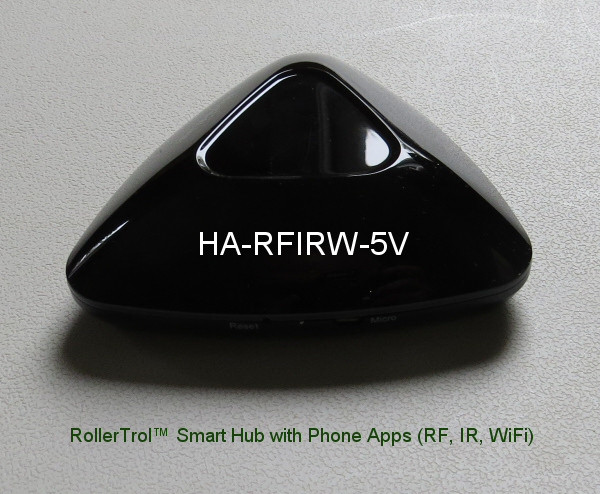
Please see this page for more information about the RF/IR controller hub.
5. The Grove Sensor and Actuator System
The final piece of the puzzle is provided by the Grove sensor and actuator system. Grove is a very easy "building block" approach to the need for sensing the environment and controlling motors and other devices to respond to changing conditions.
The Grove system has a standardized connector system (and enclosures) that facilitate a "plug 'n play" type of building-block approach to setting up a network of sensors and actuators. This picture shows the motherboard "hat" that sits on top of the Pi, with 4 common sensors that simply plug into the motherboard with the provided cables. There is a Node-RED plug-in for Grove.
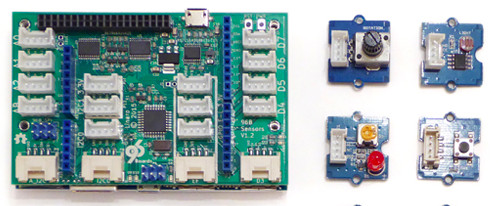
There are hundreds of different Grove sensors and actuators available; here are a few typical Grove devices arranged in various categories.
Where To Go From Here?
As of this writing, all 5 elements of our automation solution have matured considerably, and form the basis of a fully functional automation and computing environment.
The Raspbian operating system comes complete with email, a browser, an office suite, and many other useful programs. If you are just entering the world of computers, the Pi would not be a bad choice as an entry machine because the Node-RED automation software runs quietly in the background.
You can purchase motors for blinds and window openers, and our control products in our DIY online automation store.
Stay tuned, if you're interested; we are going to take the journey into automation and write about every step we take!
Adrian Biffen
Senior Partner
RollerTrol Automation Systems
We sincerely hope you enjoy our advanced technology products; if you have any questions, please contact us at any time!

 Shopping Cart Home - Start Here
Shopping Cart Home - Start Here Z-Wave Motor Control
Z-Wave Motor Control Remote Controls for Radio Equipped Motors
Remote Controls for Radio Equipped Motors DIY Starter Kits for Window Shades
DIY Starter Kits for Window Shades DIY Starter Kits for Window Openers
DIY Starter Kits for Window Openers Alexa & Broadlink RM4 Pro Home Theater Control
Alexa & Broadlink RM4 Pro Home Theater Control Zwave Motor Control: Introduction
Zwave Motor Control: Introduction Shelly WiFi Wireless Motor Control
Shelly WiFi Wireless Motor Control Zigbee Motor Control (Under Development)
Zigbee Motor Control (Under Development) Raspberry Pi as a Home Automation Hub
Raspberry Pi as a Home Automation Hub Hubitat Elevation & Broadlink RM Pro Emitter
Hubitat Elevation & Broadlink RM Pro Emitter Blind Motors
Blind Motors Window Openers
Window Openers Skylight Openers
Skylight Openers Shade Slider
Shade Slider Curtain Closer
Curtain Closer Track Glider
Track Glider Background & Mission Statement
Background & Mission Statement Customer DIY Testimonials
Customer DIY Testimonials Contact Page
Contact Page